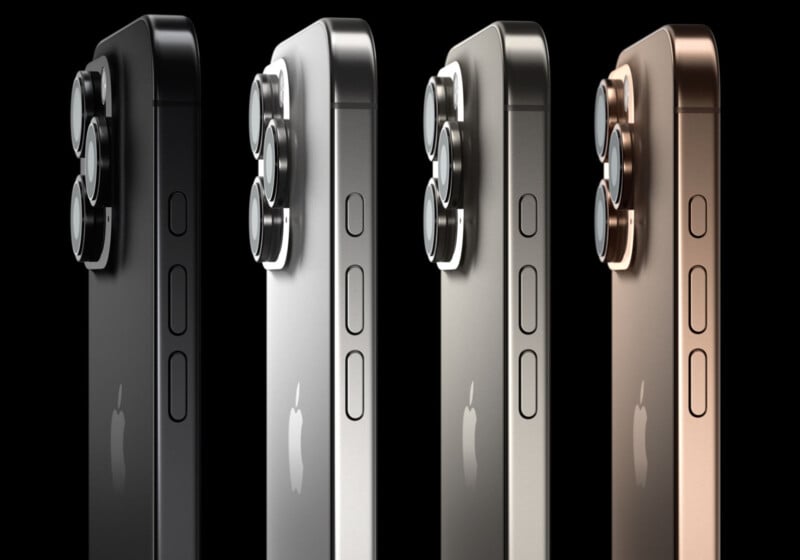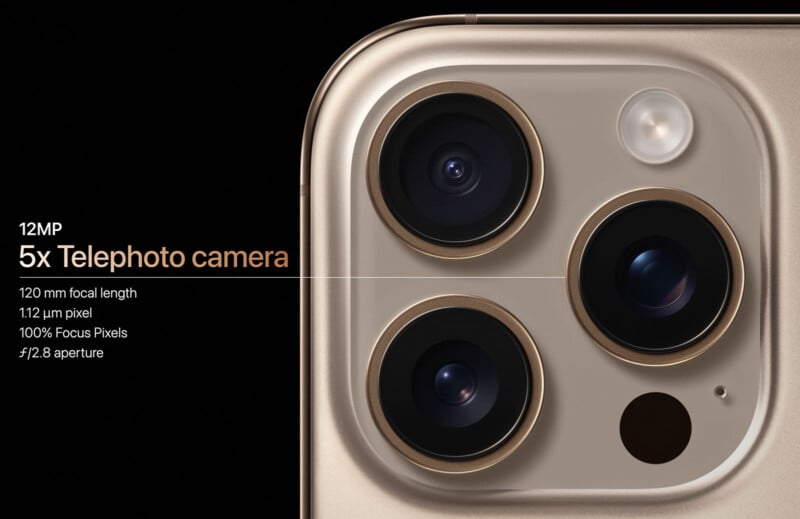![]()
During Apple’s “It’s Glowtime” event today at Apple Park in California, the tech giant announced its new flagship smartphones, the iPhone 16 Pro and iPhone 16 Pro Max. The premium phones offer much excitement for mobile photographers and videographers.
Although both new iPhone Pro models look a lot like their predecessors at first glance, there is a fair bit that has changed both inside and out. There are the expected improvements, like the move to new, faster A18 processors — which will surely drive some of Apple’s AI features in iOS 18 and beyond — but there are also some surprising tweaks, such as larger screens and slimmer bezels.
![]()
“Powered by the faster, more efficient A18 Pro chip and built for Apple Intelligence, iPhone 16 Pro and iPhone 16 Pro Max are the most advanced iPhone models we’ve ever made,” says Greg Joswiak, Apple’s senior vice president of Worldwide Marketing.
“Customers who are looking for the best possible iPhone will be able to take advantage of this huge step forward, whether they’re applying edits to a photo without lifting a finger, rewriting meeting notes for a more professional tone, or using the advanced camera system to capture their next masterpiece in 4K120 fps in Dolby Vision — all while enjoying extraordinary battery life.”
![]()
The iPhone 16 Pro has a new 6.3-inch display, up from 6.1 inches, while the iPhone 16 Pro Max has a 6.9-inch screen, up from 6.7 inches. The larger displays are Apple’s biggest iPhone display ever, and Apple calls them its best ever. The smartphones are only slightly larger, though, as the increased display size is primarily due to thinner bezels.

The iPhone 16 Pro comes in four new grade 5 titanium finishes, including a brand-new desert titanium. Each color has contrasting side colors and frosted back glass.
For photographers, perhaps the most welcome change is that customers no longer need to opt for the larger Max device to get all of Apple’s latest imaging technology. While the iPhone 15 Pro received upgrades, the iPhone 15 Pro Max exclusively got Apple’s “tetraprism” 5x telephoto camera. Google recently took a dig at Apple for this when it announced that the Google Pixel 9 Pro and 9 Pro XL had the same exact cameras and photo features. Apple has put salve on that burn in short order.

The iPhone 16 family, including the Pro models, has been designed from the ground up for Apple Intelligence. In its presentation, Apple specifically called out photographers, saying that shutterbugs can use Apple Intelligence to analyze a scene (like whether it’s photogenic) and find specific photos they’re looking for.
![]()
Apple Intelligence requires powerful processors, so the iPhone 16 Pro series now comes with new A18 Pro chips, built on a three-nanometer standard and designed explicitly for Apple Intelligence. The updated chips handle AI tasks up to 15% and promise desktop-class performance across the board, including CPU and GPU-intensive tasks, like games.
![]()
Speaking of games, ray tracing is twice as fast on the A18 Pro than the A17 Pro found in the iPhone 15 Pro. Apple calls the A18 Pro the most powerful chip available in any smartphone. The A18 Pro offers faster USB speeds, a new image signal processor, speedier encoding, and dedicated media engine support compared to the A18 featured in the iPhone 16 and iPhone 16 Plus.
Camera Features: New 48MP Main and Ultra Wide Cameras
The iPhone 16 Pro “empowers creativity across photos and videos,” per Apple, thanks to hardware and software integration, plus Apple Intelligence.
![]()
iPhone 16 Pro has a new 48-megapixel Fusion Camera and an innovative interface. The new 48-megapixel camera has a second-generation Quad Pixel sensor that can read data twice as fast, enabling swifter performance, especially when shooting action.

The Ultra Wide camera has also been redesigned, introducing a 48-megapixel sensor, up from 12 megapixels.

The 5x telephoto camera from the iPhone 15 Pro Max has made its way to the iPhone 16 Pro and Pro Max, so photographers get 5x telephoto capabilities without needing to opt for the larger model.
Dedicated Camera Control Button
The iPhone 16 Pro features a new touch-sensitive Camera Control button. Using the surface, photographers can zoom or adjust camera settings by just swiping on the button’s surface. Pressing and double-pressing also have their own functions, and an update later this year will add more focusing and exposure metering functions.
![]()
![]()
Photographic Styles
The image processing pipeline is vital to mobile photography. Apple is leveraging this pipeline for a new Photographic Styles feature, enabling photographers to fine-tune specific looks for their photos. People can easily swap through these styles using the Camera Control button.
![]()
“Unlike filters, which often use a one-size-fits-all approach by adding a color to an entire scene, adjustments are applied to specific colors of a selected style,” Apple explains. “A wider set of styles offers more creative options for editing a photo’s aesthetic, and styles can be further personalized with an easy-to-use new control pad and intensity slider for simultaneous adjustments across tone and color. These adjustments can be rendered during live preview, applied after a photo is taken, or even reversed later.”
![]()
Adjustments can be made to specific colors and tones so users can precisely grade their images. It’s possible to adjust the hue of just one color in a scene or apply color adjustments to only shadows or highlights. Photographic Styles also understand skin tones, including undertones, providing a lot of control for how people are rendered in an image.
![]()
4K/120p Video
The iPhone 16 Pro family boasts major video upgrades, too. The phones now record 4K video at up to 120p, which is made possible by the faster 48MP Fusion camera system.
4K/120p can be used in regular video recording or slow-mo mode and promises cinema-quality performance, including Dolby Vision HDR recording. Users can adjust the playback speed after the fact, so there’s no need to select slow motion at the time of capture. This should enable interesting speed ramping options for videographers using iPhone 16 Pro.
When using a compatible SSD attached via the phone’s USB-C port, video shooters can capture 4K/120p ProRes and log footage, too.
Audio matters, too, and both iPhone 16 Pro phones include a brand-new four-mic array to capture high-quality spatial audio.
![]()
Sample Images
![]()
![]()
![]()
![]()
![]()
![]()
Pricing and Availability
The iPhone 16 Pro starts at $999 for 128GB, and the iPhone 16 Pro Max is $1,199 for a 256GB base model. Preorder starts this Friday, and the iPhone 16 Pro models will be available on September 20.
![]()
PetaPixel is on hand at Apple’s headquarters for the event and will be publishing initial hands-on impressions of the new iPhone 16 Pro smartphone later today.
Image credits: Apple
